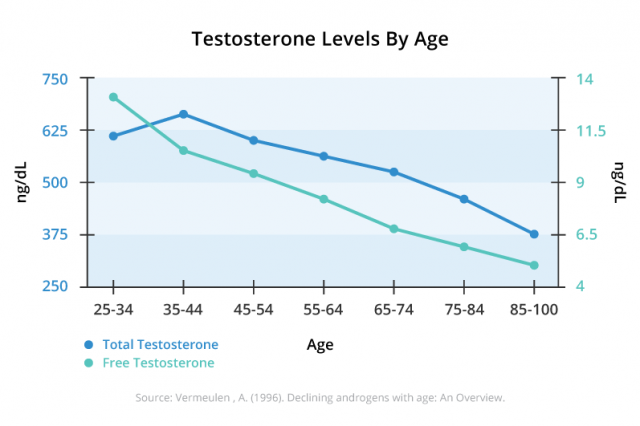Reliable Source To Get Your Testosterone
Testosterone therapy is intended to treat male hypogonadism (low testosterone or "Low T"), a condition in which the body fails to make enough hormones because of a problem with the testicles, pituitary gland or brain. A number of prescription testosterone products are available to treat hypogonadism. Testosterone products come in different forms, including gels, injectable solutions, patches, pills and pellets implanted under the skin.
Once a patient starts testosterone therapy, the patient usually undergoes lifelong treatment. Doctors will monitor the patient's hormone levels every six months to a year. Depending on the patient, the checkups may be more frequent.
Fast Facts: Use of Testosterone Therapy Over the Years
- American men spend $2 billion on testosterone each year
- Four times as many men used testosterone products in 2014 than in 2000
- In 2013, 2.3 million Americans were being treated with testosterone therapy
- In 2011, nearly one in 25 men in their 60s was taking testosterone
- Prescription sales of testosterone increased from $18 million in 1988 to $1.6 billion in 2011
Types of Testosterone Products
Testosterone can be administered in skin patch, skin gel, pill or cream form — or as an injection, a solution applied to the armpit or a patch or a buccal system applied to the upper gum or inner cheek.
While many testosterone products are available only with a prescription, some drug stores and health food stores sell them over the counter. A few of these products also claim to be all-natural.
Gels (Androgel and Testim)
Testosterone gel is a prescription medication applied directly to a man's skin —on the shoulders and upper arms and/or abdomen, depending on the brand. Testosterone gel can inadvertently transfer from your body to others and can lead to serious health reactions. To avoid such contact, apply testosterone gel to clean, dry, intact skin that will be covered by clothing. Wash your hands right away with soap and water after applying. Once the gel has dried, cover the area with clothing and keep it covered until you have washed the area well or have showered.
Injections (Depo-Testosterone)
First approved in 1979, Depo-testosterone is one of the older drugs of its kind on the market. It's a liquid and is designed for injection deep into the gluteal muscle. The active ingredient, testosterone cypionate, is a white or creamy white powder mixed with other ingredients to make a solution. The drug is available in two strengths, 100 mg and 200 mg.
Patches (Androderm)
Testosterone transdermal patches, including Androderm, come as patches to apply to the skin. Patches work best when applied around the same time each night and are left in place for 24 hours. Testosterone patches are meant to be worn at all times until replaced with new patches. Androderm patches should be changed every 24 hours. The old patch should be removed before applying the new one. You should apply the patches to different spots each night and wait at least seven days before re-using a spot.
Capsules (Methyltestosterone and Android)
The testosterone capsules Methyltestosterone and Android have been discontinued but have been used in men and boys to treat conditions caused by lack of hormone, such as delayed puberty, and in women to treat breast cancer that has spread to other parts of the body. Methyltestosterone is a man-made form of testosterone. It can affect bone growth in boys who are treated for delayed puberty.
Boosters (Testofen)
Manufacturers of testosterone boosters like Testofen have touted their products as means to increase muscle mass, strength and sex drive in men. Among the most popular testosterone boosters are products that contain some combination of tribulus terrestris, DHEA, zinc and d-aspartic acid. These ingredients have been associated with a number of side effects, including aggressiveness, breast enlargement, cholesterol changes, prostate problems and an increased risk of cardiovascular disease.
Makers of testosterone products use two types of hormones:
- Bioidentical Hormones
- AndroGel and a number of other products contain bioidentical hormones. Scientists create bioidentical hormones in a lab to chemically match the hormone naturally made by the body. In theory, this results in fewer side effects.
- Synthetic Hormones
- Synthetic hormones are altered from the original chemical makeup, so they do not match those made by the body. These types of drugs typically have more side effects.
Why Men Use Testosterone Therapy
Unusually high or low levels of testosterone can significantly affect a man's physical and mental health. Men typically use testosterone drugs to address a medical issue — like Low T or erectile dysfunction— or to enhance their physical performance

Men use testosterone therapy to enhance their physical performance
Treating Low T
Testosterone levels in men start to spike during puberty and drop on average by 1 percent every year after age 30. Lack of this key sex hormone in older men can cause health issues, including osteoporosis, loss of muscle mass and strength (sarcopenia), and psychological symptoms. Doctors prescribe testosterone drugs to treat these symptoms.
While declining testosterone levels tend to be part of normal aging in men, others experience the dip because of disorders of the testicles, pituitary gland and brain that cause hypogonadism. Other factors — such as injury to the testicles, cancer treatments, chronic diseases and stress — can also contribute to low testosterone production.
The FDA approved testosterone as replacement therapy only for men who have low testosterone levels due to disorders that cause hypogonadism. However, the agency has said testosterone is being widely used to try to relieve symptoms in men who have low testosterone for no apparent reason other than aging — a use for which the benefits and safety have not been established.

EXPAND
Declining Testosterone Levels by Age
Doctors analyze testosterone levels in two categories: total testosterone and free testosterone. Most testosterone is attached to a protein called sex hormone-binding globulin (SHGB). A small amount of testosterone is free, and a small amount regularly attaches and detaches itself from a protein called albumin. Any testosterone that is not attached to SHGB is considered free testosterone.
Remedying Erectile Dysfunction
Some men turn to testosterone to increase sex drive and treat erectile dysfunction (ED), which is the inability to get and keep erections. In fact, according to an article published by Harvard Health Publications, some doctors used it to treat ED before Pfizer released Viagra in 1998.
"It's well established that testosterone by itself, for men with sexual dysfunction that includes erectile dysfunction, can improve erections in the majority of men who take it."
However, only about 5 percent of men experience ED solely from low testosterone. Low testosterone levels can be a contributing factor to ED but are more likely to reduce sexual desire than cause ED. Many doctors won't consider prescribing testosterone to a patient unless he presents certain other symptoms, too.
Dr. Abraham Morgentaler is an advocate of using testosterone for treating men with sexual dysfunction, including ED.
Morgentaler does admit that some men may require testosterone and Viagra, however, in order to have adequate erections.
Enhancing Physical Performance
Because testosterone allows men to increase muscle mass and performance, athletes and body builders use testosterone-boosting supplements and drugs to increase strength and improve recovery time. The practice of using these drugs is called "doping." Athletes use both synthetic and bioidentical supplements. Body builders in particular are known for their use of synthetic hormones to rapidly increase muscle mass.
"Testosterone can help increase muscle mass in a much faster fashion. Athletes who use anabolic steroids may find that they're able to increase their endurance and their strength by doing the same amount of training as they would otherwise," Dr. Anthony Yin, an endocrinologist at California Pacific Medical Center in San Francisco, told SF Gate.
However, using performance-enhancing drugs, testosterone included, is illegal in most sports. While the drug is helpful to men who are clinically diagnosed with Low T, men who abuse these drugs solely to boost performance face a number of possible side effects.
Critics and Risks
As use of testosterone therapy has increased so has the amount of concern surrounding these products.
Some doctors say that in reality, few men are actually diagnosed with clinical hypogonadism, and that many "symptoms" are just a normal part of aging. A study published in the Journal of Clinical Endocrinology & Metabolism shows record numbers of men in the U.S. are turning to testosterone therapy simply to increase their sex drive and energy levels.
Critics say that Low T is a condition marketed by drug companies to increase profits. Doctors are concerned that the long-term effects have not yet been properly studied and feel there should be more agreement about what constitutes a normal testosterone level. Because testosterone therapies are not proven treatments, they caution that risks may outweigh benefits for healthy men.
Dr. Lisa Schwartz, a professor at the Dartmouth Institute for Health Policy and Clinical Practice, wrote a paper on drug companies marketing these hormone therapies.
"We're giving people hormones that we don't know they need for a disease that we don't know they have, and we don't know if it'll help them or harm them."
Over the years, men have sued the makers of testosterone products after using the therapies and suffering from heart attacks, strokes and blood clots. Meanwhile, researchers have conducted studies to better understand the effects of testosterone therapy.
Recent Clinical Trials
Researchers for a year studied the effect of testosterone treatment on cognition, bone health, anemia and cardiovascular health in 788 men aged 65 or older who had low testosterone levels that couldn't be explained by anything other than age.
According to the findings, reported in February 2017 in JAMA and JAMA Internal Medicine, testosterone treatment did not have an effect on memory or cognitive abilities, though it appeared to increase hemoglobin levels in men with anemia and improve bone density. In addition, a clinical trial found one year of testosterone treatment in men aged 65 or older with Low T was associated with a significant increase in coronary artery plaque, a risk factor for heart disease.
Heart Attacks and Other Side Effects
Studies have linked testosterone products to serious side effects, prompting the FDA to take action in recent years to warn the public of the potential dangers of these products.
Testosterone therapy is associated with an increased risk for these health problems:
- Heart Attacks (mainly in male patients over 65 and patients with diagnosed heart disease)
- Stroke
- Blood Clots
- Polycythemia (high levels of red blood cells that can lead to blood clots and stroke)
- Worsening of Sleep Apnea
- Hormonal Imbalance
- Prostate Cancer
Dangers to Women, Children & Pets
Testosterone therapy for men can be dangerous to women and children if they come in contact with the drug by touching the patient's skin. This usually occurs when men use testosterone gel and the application site is exposed. Anyone who comes in contact with the application site is at risk of developing side effects.
Women can experience acne or hair growth, and if they are pregnant, the unborn baby may be harmed.
In 2009, the FDA issued a warning about adverse effects in children exposed to testosterone gels through contact with application sites. Symptoms included abnormally large genitalia (penis and clitoris), advanced bone age, early puberty and aggressive behavior. Young boys may even develop enlarged breasts. A doctor should be contacted right away if these symptoms occur.
Pets exposed to testosterone can become violent and aggressive and develop enlarged genitals.
Reliable Source To Get Your Testosterone
Source: https://www.drugwatch.com/testosterone/

